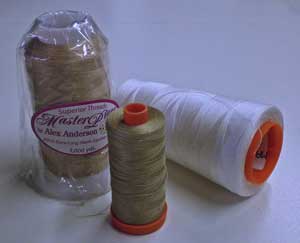This post contains affiliate links for which I receive compensation
Machine quilting tension problems
by Melody
(Illinois)
I am a rather new quilter. I have been doing this for about 5 years but little at a time. Every time I machine quilt the bottom is messy. I tried moving the tension but I can't seem to get it right.
What is the key to the tension?
Reply
The key to tension is testing. And then using the testing to help you identify the problem or problems.Let's see if we can identify where the problem is coming from.
Is it the machine?
Since you wrote that this happens 'every time' you machine quilt, I would want to either rule out or identify that your sewing machine is the culprit. So...How does the tension look for piecing?
If you're making lots of tension adjustment for piecing, I'd take the machine in for a 'well-baby' check-up.
Sewing machines are engineered to sew using the same weight thread in the needle and bobbin. When we're piecing it's more likely that we quilters will use the same thread both.
Any tension adjustments should be small, if at all, to accommodate the difference in thread weight.
Are the tension problems the same whether your are quilting with a walking foot or a darning foot?
If the tension is a mess regardless of the foot you're using, then again, I'd suggest taking it in for a check-up. That's because it's messed up under two very different sets of conditions...
- With a walking foot installed the machine is control of speed and stitch length, you are merely guiding the quilt sandwich.
- With a darning or free motion foot installed you are in control of everything except physically creating the stitch.
Do you need to adjust the tension itself?
Loops on the back of the quilt sandwich that occur consistently over all types of quilting—straight or curved lines and direction reversals—require actual adjustments to the tension itself. For more information please see "Adjusting Sewing Machine Tension to Prevent Problems.What types of threads are you using?

As mentioned earlier, sewing machines are engineered to stitch with the same thread in the needle and bobbin. Use a practice quilt sandwich, made from the fabric and batting types you most usually use. Thread up your machine with a quality 50wt cotton like Aurifil or Masterpiece.
I suggest these because the tension adjustments, if needed, should be minor.
Test.
How does this compare to your other quilting sessions? If it's better, then, for now, try to plan your quilting with the same brand and weight of thread both needle and bobbin. Using different threads in the needle and bobbin will almost always require at least slight tension adjustments.
Is it a matter of practice?
If the tension problems are the most visible during free motion quilting, but only during certain aspects of free motion quilting, then it may simply boil down to needing more regular practice to develop the feel for this kind of quilting.Do the tension problems occur most frequently on curves or where line of quilting reverses itself (like the points of a star)?
Then the tension problems are coming from the combination of hand and stitching speed.
'Eyelashing', a common tension problem, occurs when the quilter 'whips' around a curve by suddenly increasing the hand speed.
Practice moving your hands and the quilt sandwich at a steady pace, regardless of the direction you're quilting. (This is where those practice quilt sandwiches come in handy. Practice the direction you have the most problems quilting.)
If you have 'speed control' on your sewing machine, reduce the speed to, say, 50-75% of full speed. This will take one variable out of the machine quilting equation.
Practice will help you determine your own 'comfortable' quilting speed, but I wager it'll be something less than full speed. You'll have more control.
Do thread knobs or nubs form at points (i.e. where you reverse the stitching direction)?
This happen because you've paused for too long in one place with the needle moving. Again, practice this motion repeatedly on a practice sandwich.
Final words...
For my own learning curve, I spent a lot of time practicing once I'd made up my mind to learn free motion quilting. It certainly helped to create the muscle memory so that I know how it should 'feel' while stitching.But the biggest boost was to my confidence.
Am I an award-winning quilter?
Nope.
Just a gal who likes to quilt. But the practice gave me confidence.
Now when I sit down to quilt, no matter how long I've been away from my machine, I know the ability is right there, just waiting to be tapped into. Knowing that I can do it, changes my attitude when my machine acts up...and it does from time to time.
Melody, I hope I've been able to help in some small way. If the machine quilting portion of making a quilt it important to you, one that you WANT to learn, then find a way to give yourself the gift of time for more practice. You'll reap the benefits!
Piecefully,
Julie Baird
Editor
Comments for Machine quilting tension problems
|
||
|
||
|
||
|
||














